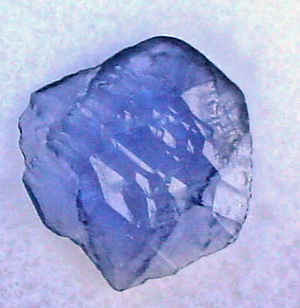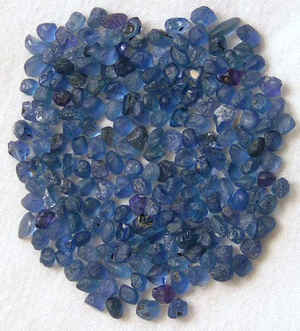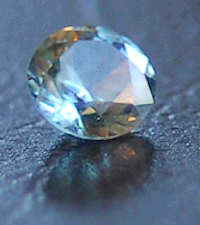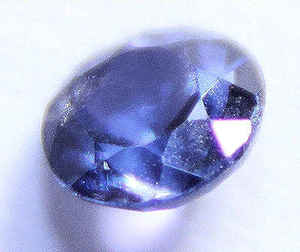

Montana Symbols
Montana State Gemstone
Yogo Sapphire

( Al2O3)
Adopted in 1969.
Montana designated both the sapphire and Montana Agate as the official state gemstones of Montana in 1969. Agates are found in southern and eastern Montana. Agate is polished (not cut) to make gemstones and jewelry. Agates are usually white with swirls of grey and black spots.
Montana sapphires and Montana agates have shared honors as the state's gemstones since 1969. Recognition was a long time in coming. A century earlier the small multi-colored sapphires angered early placer miners by clogging gold sluices in such places as El Dorado Bar east of Helena. "Sapphire Collins" frequented the streets of Helena in the 1860s with a pocket full of pretty stones. Try as he might to convince local merchants and bankers of the stones' value, he was told bluntly that gold was of prime importance and that anything else was of little worth.
Montana sapphires and Montana agates have shared honors as the state's gemstones since 1969. Recognition was a long time in coming.
Yogo Sapphire: Montana State Gemstone or Gem

All gem quality corundum {name derived from the Sanskrit, kuruvinda ("Ruby")} that is not red is called sapphire such as blue, orange, yellow, violet, green, white and pink. A century earlier the small multi-colored sapphires angered early placer miners by clogging gold sluices in such places as El Dorado Bar east of Helena. "Sapphire Collins" frequented the streets of Helena in the 1860s with a pocket full of pretty stones. Try as he might to convince local merchants and bankers of the stones' value, he was told bluntly that gold was of prime importance - anything else was of little worth.
Eastern and European financiers weren't as shortsighted when they learned of Montana's sapphires in the early 1890s. Before long, substantial companies
from as far away as London invested in sapphire mines throughout the state.
On Quartz and Rock Creeks west of Philipsburg, or Brown's Gulch and Dry Cottonwood Creek east of Anaconda, or along the Missouri River at El Dorado
Bar, French Bar, Magpie Gulch, Metropolitan Bar, and elsewhere, the rush was on. But the sapphire bonanza came in at Yogo Gulch in central Montana's
Judith Basin Gulch.

Jake Hoover, friend of cowboy
artist Charles Russell, made one of the earliest discoveries of Yogo sapphires. Looking for gold, he found the blue pebbles in the gravels of Yogo
Creek in 1896. The Yogo mines attracted wide attention and capital. The US Geological Survey termed the location "America's most important gem location."
The British controlled the mines for nearly thirty years, explaining why the beautiful "Cornflower Blue" Yogos are found in the Royal Crown Jewel Collection
in London. A unique quality of Yogo sapphires is that they retain their brilliance under artificial light. Sapphires from other parts of the world
generally absorb artificial light, making them appear black and lusterless.
 Yogo's are unique among the world's
sapphires. They lack the color zoning so prevalent in other sapphires, their uniform "corn-flower blue" color is natural (not the result of heat-treating),
and their clarity is uniformly high. However, less known is that all colors of sapphires (every color of corundum except red), are mined in the Rock
Creek area of Montana. For example, they get various shades of pink, yellow, gold, white, and blue-green. All come in high quality, although quantity
is limited in the fancy colors, depending on size, color, etc. Blues and blue-green sapphires are the most prevalent. These features rank them among
the world's finest sapphires. Unfortunately, the rough is both small and flat, wafer-like in shape. The majority of the crystals or pieces of crystals
recovered are too small to be cut, most are less than 1 carat and finds of over 2 carats are rare. Reportedly, the largest crystal was a 19 carat stone
found in 1910 that was cut into an 8-carat stone. The size of the cut stones greatly restrict the market for Yogo's, they are beautiful, small, very
expensive sapphires. The largest cut Yogo is 10.2 carats and is in the Smithsonian Institution in Washington, D.C.
Yogo's are unique among the world's
sapphires. They lack the color zoning so prevalent in other sapphires, their uniform "corn-flower blue" color is natural (not the result of heat-treating),
and their clarity is uniformly high. However, less known is that all colors of sapphires (every color of corundum except red), are mined in the Rock
Creek area of Montana. For example, they get various shades of pink, yellow, gold, white, and blue-green. All come in high quality, although quantity
is limited in the fancy colors, depending on size, color, etc. Blues and blue-green sapphires are the most prevalent. These features rank them among
the world's finest sapphires. Unfortunately, the rough is both small and flat, wafer-like in shape. The majority of the crystals or pieces of crystals
recovered are too small to be cut, most are less than 1 carat and finds of over 2 carats are rare. Reportedly, the largest crystal was a 19 carat stone
found in 1910 that was cut into an 8-carat stone. The size of the cut stones greatly restrict the market for Yogo's, they are beautiful, small, very
expensive sapphires. The largest cut Yogo is 10.2 carats and is in the Smithsonian Institution in Washington, D.C.
Currently, Yogo sapphires are produced from three sources: Rancor lnc., produces material from the original Yogo Gulch deposit; Vortex Mining produces from a recently discovered extension of the Yogo dike; and material is produced by individuals from privately owned lots in Sapphire Village. The first two producers market only cut stones and finished goods and the third is comprised essentially of hobbyists.
Between the sapphire and the agate, Montana's east and west, heritage and hobbies, are represented.
Montana Law
The law designating the sapphire as the official Montana state gem stone is found in the Montana Code, Title 1, Chapter 1, Part 5, Section 1-1-505.
Title 1. GENERAL LAWS AND DEFINITIONS
CHAPTER 1. GENERAL PROVISIONS
Part 5. State Symbols - Official Designations
1-1-505. State gem stones.
Universal Citation: MT Code § 1-1-505 (2013)
1-1-505. State gem stones. The sapphire and the Montana agate are the official Montana state gem stones.
History: En. Sec. 1, Ch. 20, L. 1969; R.C.M. 1947, 19-123.
General Corundum Information
Chemical Formula: Al2O3
Composition: Molecular Weight = 101.96 gm
Aluminum 52.93 % Al 100.00 % Al2O3
Oxygen 47.07 % O
Total 100.00 % 100.00 % = TOTAL OXIDE
Empirical Formula: (Al2O3 )
Environment: Contact and regionally metamorphosed rocks.
IMA Status: Valid Species (Pre-IMA)
Locality: Tchainit and Yakutia, Russia.
Name Origin: Derived from the Sanskrit, kuruvinda ("Ruby")
Minerals, & Gems

Gemstone, Minerals, Rocks





